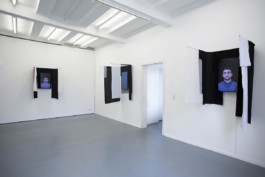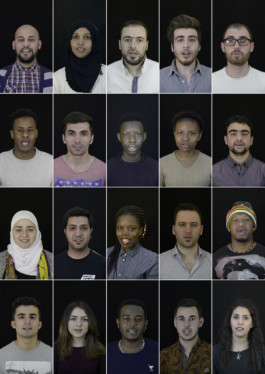Niklaus Anton Martha Emil (N.A.M.E.)
니클라우스 안톤 마르다 에밀(네임)
2017, 5-channel video installation, loop
2017, 5채널 비디오설치, 연속재생

Installation view, <CEEHIILNPSSWZ. ACH MENSCH>(2017, Braunschweig Foto Museum, DE)
The video installation takes the form of video portraits of 20 people who have emigrated to Germany. They introduce themselves by saying their names in German, using the alphabet (A-Anton, B-Bertha, C-Cezar.... ), which helps to reduce pronunciation errors and ensure correct spelling over the phone and telegraph in Germany, and tell a story about the meaning or anecdote of their name.
Names are a point of identity establishment that is linked to social acceptance, cultural traditions, personal experience, and family heritage. While language primarily functions as a social gateway, it is at the same time confronted with its limitations. The language transferred from the mother tongue creates gaps, shortened names, and differences in meaning that raise questions about plural identities.
이 영상 설치에는 독일로 이주한 20명의 ‘영상 초상’의 형태이다. 이들은 독일에서 전화, 전신에서 발음의 오류를 줄이고 철자를 정확하게 말하는 데에 도움을 주는 알파벳표(A-An- ton, B-Bertha, C-Cezar.... )를 이용해 독일어로 자신의 이름을 말하며 스스로를 소개하고, 자신의 이름에 관한 의미나 에피소드를 들려준다.
이름을 통해서 사회의 수용성, 문화적 전통, 개인적 경험, 가족 유산과 연관된 정체성을 확립하는 지점을 확인한다. 언어가 주로 사회적 입구로 기능하는 반면에, 여기에서는 그와 동시에 언어가 가진 한계에 부딪힌다. 모국어로부터 이전된 언어는 그 사이에 빈 간격, 이름의 단축 그리고 의미의 차이를 만들어내고, 이로부터 복수의 정체성에 대한 질문을 던진다.

Thanks to
Goli, Alzain, Abodi, Samer, Arman, Majid / Stefan, Joudi, Basel, Abeer, Nancy, Petros, Ahmadi, Alieu, Bagaza, Hussin, Ayanle, Dahabo, Alberta, Safuan, Fanta
Supported by
Braunschweig civil foundation, DE 독일 브라운슈바익 시민재단
Niklaus Anton Martha Emil (N.A.M.E.)
니클라우스 안톤 마르다 에밀(네임)
2017, 5-channel video installation, loop
2017, 5채널 비디오설치, 연속재생

Installation view, <CEEHIILNPSSWZ. ACH MENSCH>(2017, Braunschweig Foto Museum, DE)
The video installation takes the form of video portraits of 20 people who have emigrated to Germany. They introduce themselves by saying their names in German, using the alphabet (A-Anton, B-Bertha, C-Cezar.... ), which helps to reduce pronunciation errors and ensure correct spelling over the phone and telegraph in Germany, and tell a story about the meaning or anecdote of their name.
Names are a point of identity establishment that is linked to social acceptance, cultural traditions, personal experience, and family heritage. While language primarily functions as a social gateway, it is at the same time confronted with its limitations. The language transferred from the mother tongue creates gaps, shortened names, and differences in meaning that raise questions about plural identities.
이 영상 설치에는 독일로 이주한 20명의 ‘영상 초상’의 형태이다. 이들은 독일에서 전화, 전신에서 발음의 오류를 줄이고 철자를 정확하게 말하는 데에 도움을 주는 알파벳표(A-An- ton, B-Bertha, C-Cezar.... )를 이용해 독일어로 자신의 이름을 말하며 스스로를 소개하고, 자신의 이름에 관한 의미나 에피소드를 들려준다.
이름을 통해서 사회의 수용성, 문화적 전통, 개인적 경험, 가족 유산과 연관된 정체성을 확립하는 지점을 확인한다. 언어가 주로 사회적 입구로 기능하는 반면에, 여기에서는 그와 동시에 언어가 가진 한계에 부딪힌다. 모국어로부터 이전된 언어는 그 사이에 빈 간격, 이름의 단축 그리고 의미의 차이를 만들어내고, 이로부터 복수의 정체성에 대한 질문을 던진다.
Thanks to
Goli
Alzain
Abodi
Samer
Arman
Majid / Stefan
Joudi
Basel
Abeer
Nancy
Petros
Ahmad
Alieu
Bagaza
Hussin
Ayanle
Dahabo
Alberta
Safuan
Fanta
